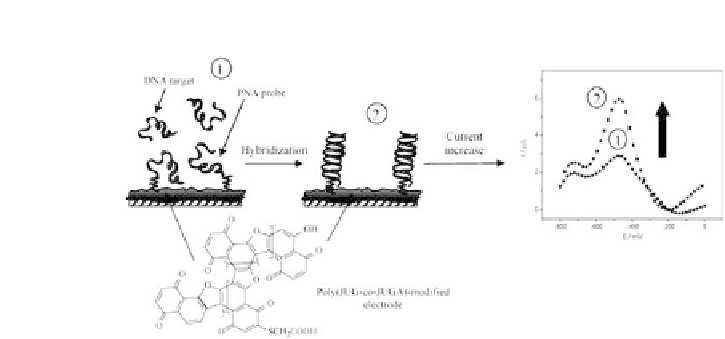Biology Reference
In-Depth Information
Figure 7.7.
Working principle of the DNA electrochemical sensor based
on a PNA functionalized conductive polymer. Reprinted from
Talanta
,
76
,
S. Reisberg, L. A. Dang, Q. A. Nguyen, B. Piro, V. Noel, P. E. Nielsen, L. A. Le,
and M. C. Pham, Label-free DNA electrochemical sensor based on a PNA-
functionalized conductive polymer, 206-210, 2008, with permission from
Elsevier.
Here, the PNA capture probe was covalently attached to a
quinine-based electroactive polymer. Changes in flexibility of the
PNA probe strand upon hybridization generate electrochemical
changes at the polymer-solution interface. A reagentless and
direct electrochemical detection was achieved by detection of the
electrochemicalchangesusingsquarewavevoltammetry(SWV).An
increase in the peak current of quinoneis observed upon hybridiza-
tionofprobetothetarget,whereasnochangeisobservedwithnon-
complementarysequences.Inaddition,thebiosensorcaneffectively
discriminate a single mismatch on the target sequence. A different
PNA based sensor that does not require probe immobilization
was proposed by Luo
et al.
[61]. This method involves solution
phase hybridization of a Fc-labeled PNA and its complementary
DNA sequence, followed by the electrochemical detection of Fc-
PNA-DNA hybrid on indium tin oxide (ITO)-based substrates. Due
to the electrostatic repulsion between the negatively charged ITO
surface and the negatively charged DNA reduced electrochemical
signal was observed in respect to signal observed for neutral Fc-
PNA conjugate. However, when the ITO electrode was coated with
apositivelychargedpoly(allylaminehydrochloride) (PAH)layer,the








